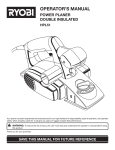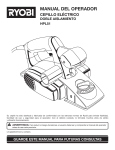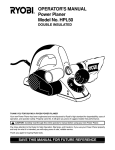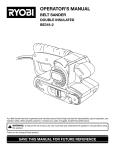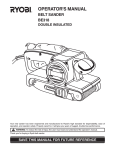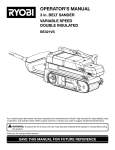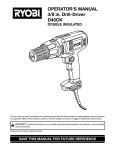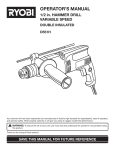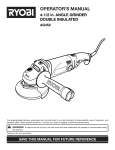Download Ryobi HPL51 Operator`s manual
Transcript
OPERATOR'S MANUAL Power Planer Model No. HPL51 DOUBLE INSULATED Your new Power Planer has been engineered and manufactured to Ryobi’s high standard for dependability, ease of operation, and operator safety. Properly cared for, it will give you years of rugged, trouble-free performance. WARNING: To reduce the risk of injury, the user must read and understand the operator’s manual before using this product. Thank you for buying Ryobi tools. SAVE THIS MANUAL FOR FUTURE REFERENCE TABLE OF CONTENTS ■ Introduction ............................................................................................................................................................ 2 ■ General Safety Rules ........................................................................................................................................ 3 - 4 ■ Specific Safety Rules ........................................................................................................................................ 4 - 5 ■ Symbols ............................................................................................................................................................ 5 - 6 ■ Electrical ................................................................................................................................................................ 6 ■ Product Specifications ............................................................................................................................................ 7 ■ Unpacking .............................................................................................................................................................. 7 ■ Applications ............................................................................................................................................................ 7 ■ Features ................................................................................................................................................................. 8 ■ Adjustments ........................................................................................................................................................... 9 ■ Operation ........................................................................................................................................................ 10- 12 ■ Maintenance .................................................................................................................................................. 13 - 15 ■ Parts Ordering / Service ....................................................................................................................................... 16 INTRODUCTION Your power planer has many features for making the use of this product more pleasant and enjoyable. Safety, performance, and dependability have been given top priority in the design of this tool making it easy to maintain and operate. WARNING: Do not attempt to operate this tool until you have thoroughly read and completely understand the operator’s manual. Pay close attention to the safety rules, including Dangers, Warnings, and Cautions. If you use this tool properly and only as intended, you will enjoy years of safe, reliable service. Look for this symbol to point out important safety precautions. It means attention!!! Your safety is involved. WARNING: The operation of any power tool can result in foreign objects being thrown into your eyes, which can result in severe eye damage. Before beginning tool operation, always wear safety goggles or safety glasses with side shields and a full face shield when needed. We recommend Wide Vision Safety Mask for use over eyeglasses or standard safety glasses with side shields. Always wear eye protection which is marked to comply with ANSI Z87.1. Page 2 GENERAL SAFETY RULES ■ WARNING: Read and understand all instructions. Failure to follow all instructions listed below, may result in electric shock, fire and/or serious personal injury. ■ SAVE THESE INSTRUCTIONS ■ Work Area ■ ■ ■ Keep your work area clean and well lit. Cluttered benches and dark areas invite accidents. Do not operate power tools in explosive atmospheres, such as in the presence of flammable liquids, gases, or dust. Power tools may create sparks which may ignite the dust or fumes. Keep bystanders, children, and visitors away while operating a power tool. Distractions can cause you to lose control. ■ ■ Dress properly. Do not wear loose clothing or jewelry. Contain long hair. Keep your hair, clothing, and gloves away from moving parts. Loose clothes, jewelry, or long hair can be caught in moving parts. Avoid accidental starting. Be sure switch is off before plugging in. Carrying tools with your finger on the switch or plugging in tools that have the switch on, invites accidents. Remove adjusting keys or wrenches before turning the tool on. A wrench or a key that is left attached to a rotating part of the tool may result in personal injury. Do not overreach. Keep proper footing and balance at all times. Proper footing and balance enables better control of the tool in unexpected situations. Do not use on a ladder or unstable support. Use safety equipment. Always wear eye protection. Dust mask, nonskid safety shoes, globes, hard hat, or hearing protection must be used for appropriate conditions. Electrical Safety Tool Use and Care ■ ■ ■ ■ ■ ■ Double insulated tools are equipped with a polarized plug (one blade is wider than the other). This plug will fit in a polarized outlet only one way. If the plug does not fit fully in the outlet, reverse the plug. If it still does not fit, contact a qualified electrician to install a polarized outlet. Do not change the plug in any way. Double insulation eliminates the need for the three-wire grounded power cord and grounded power supply system. Avoid body contact with grounded surfaces, such as pipes, radiators, ranges, and refrigerators. There is an increased risk of electric shock if your body is grounded. Do not expose power tools to rain or wet conditions. Water entering a power tool will increase the risk of electric shock. Do not abuse the cord. Never use the cord to carry the tools or pull the plug from an outlet. Keep cord away from heat, oil, sharp edges, or moving parts. Replace damaged cords immediately. Damaged cords increase the risk of electric shock. When operating a power tool outside, use an outdoor extension cord marked “W-A” or “W”. These cords are rated for outdoor use and reduce the risk of electric shock. Personal Safety ■ ■ Use clamps or other practical way to secure and support the workpiece to a stable platform. Holding the work by hand or against your body is unstable and may lead to loss of control. Do not force tool. Use the correct tool for your application. The correct tool will do the job better and safer at the rate for which it is designed. ■ Do not use tool if switch does not turn it on or off. Any tool that cannot be controlled with the switch is dangerous and must be repaired. ■ Disconnect the plug from power source before making any adjustments, changing accessories, or storing the tool. Such preventive safety measures reduce the risk of starting the tool accidentally. Store idle tools out of the reach of children and other untrained persons. Tools are dangerous in the hands of untrained users. Maintain tools with care. Keep cutting tools sharp and clean. Properly maintained tools with sharp cutting edges are less likely to bind and are easier to control. Check for misalignment or binding of moving parts, breakage of parts, and any other condition that may affect the tool’s operation. If damaged, have the tool serviced before using. Many accidents are caused by poorly maintained tools. Use only accessories that are recommended by the manufacturer for your model. Accessories that may be suitable for one tool, may become hazardous when used on another tool. ■ ■ ■ ■ Stay alert, watch what you are doing and use common sense when operating a power tool. Do not use tool while tired or under the influence of drugs, alcohol, or medication. A moment of inattention while operating power tools may result in serious personal injury. Page 3 GENERAL SAFETY RULES Service ■ ■ Tool service must be performed only by qualified repair personnel. Service or maintenance performed by unqualified personnel could result in a risk of injury. When servicing a tool, use only identical replacement parts. Follow instructions in the Maintenance section of this manual. Use of unauthorized parts or failure to follow Maintenance Instructions may create a risk of electric shock or injury. SPECIFIC SAFETY RULES ■ ■ Hold tool by insulated gripping surfaces when performing an operation where the cutting tool may contact hidden wiring or its cord. Contact with a “live” wire will make exposed metal parts of the tool “live” and shock the operator. Wait for the cutter to stop before setting the tool down. An exposed cutter may engage the surface leading to possible loss of control and serious injury. ■ Additional Rules For Safe Operation ■ ■ ■ ■ ■ ■ ■ Know your power tool. Read operator’s manual carefully. Learn its applications and limitations, as well as the specific potential hazards related to this tool. Following this rule will reduce the risk of electric shock, fire, or serious injury. Always wear safety glasses. Everyday eyeglasses have only impact-resistant lenses; they are NOT safety glasses. Following this rule will reduce the risk of serious personal injury. Protect your lungs. Wear a face or dust mask if the operation is dusty. Following this rule will reduce the risk of serious personal injury. Protect your hearing. Wear hearing protection during extended periods of operation. Following this rule will reduce the risk of serious personal injury. Inspect tool cords periodically and, if damaged, have repaired at your nearest Factory Service Center or other Authorized Service Organization. Constantly stay aware of cord location. Following this rule will reduce the risk of electric shock or fire. Keep hands away from blades and planing area. Do not reach underneath work while blades are rotating. Do not attempt to remove material while blades are rotating. Blades continue to rotate after releasing of trigger. Following this rule will reduce the risk of serious personal injury. Check damaged parts. Before further use of the tool, a guard or other part that is damaged should be carefully checked to determine that it will operate properly and perform its intended function. Check for alignment of moving parts, binding of moving parts, breakage of parts, mounting, and any other conditions that may affect its operation. A guard or other part that is damaged should be properly repaired or replaced by an authorized service center. Following this rule will reduce the risk of shock, fire, or serious injury. ■ ■ ■ ■ ■ ■ Page 4 Keep handles dry, clean, and free from oil, and grease. Always use a clean cloth when cleaning. Never use brake fluids, gasoline, petroleum-based products or any strong solvents to clean your tool. Following this rule will reduce the risk of serious personal injury. Keep blades clean. Periodically check blades and exhaust port for chip build-up. Clean blades minimize stalling and kickback. Following this rule will reduce the risk of serious personal injury. Do not abuse cord. Never carry the tool by the cord or yank it to disconnect it from the receptacle. Keep cord away from heat, oil, and sharp edges. Following this rule will reduce the risk of electric shock or fire. Make sure your extension cord is in good condition. When using an extension cord, be sure to use one heavy enough to carry the current your product will draw. A wire gage size (A.W.G.) of at least 14 is recommended for an extension cord 100 feet or less in length. A cord exceeding 100 feet is not recommended. If in doubt, use the next heavier gage. The smaller the gage number, the heavier the cord. An undersized cord will cause a drop in line voltage resulting in loss of power and overheating. Inspect for and remove all nails from lumber before planing. Following this rule will reduce the risk of serious personal injury. Drugs, alcohol, medication. Do not operate tool while under the influence of drugs, alcohol, or any medication. Following this rule will reduce the risk of electric shock, fire, or serious personal injury. Save these instructions. Refer to them frequently and use them to instruct others who may use this tool. If you loan someone this tool, loan them these instructions also. SPECIFIC SAFETY RULES WARNING: Some dust created by power sanding, sawing, grinding, drilling, and other construction activities contains chemicals known to cause cancer, birth defects or other reproductive harm. Some examples of these chemicals are: ■ lead from lead-based paints, ■ crystalline silica from bricks and cement and other masonry products, and ■ arsenic and chromium from chemically-treated lumber. Your risk from these exposures varies, depending on how often you do this type of work. To reduce your exposure to these chemicals: work in a well ventilated area, and work with approved safety equipment, such as those dust masks that are specially designed to filter out microscopic particles. SYMBOLS Important: Some of the following symbols may be used on your tool. Please study them and learn their meaning. Proper interpretation of these symbols will allow you to operate the tool better and safer. SYMBOL NAME DESIGNATION/EXPLANATION V Volts Voltage A Amperes Current Hz Hertz Frequency (cycles per second) W Watt Power min Minutes Time Alternating Current Type of current No Load Speed Rotational speed, at no load Class II Construction Double-insulated construction Per Minute Revolutions, strokes, surface speed, orbits etc. per minute Safety Alert Precautions that involve your safety Eye Protection Always wear safety goggles or safety glasses with side shields and a full face shield when operating this product. Wet Conditions Alert Do not expose to rain or use in damp locations. n0 /min Page 5 SYMBOLS The purpose of safety symbols is to attract your attention to possible dangers. The safety symbols, and the explanations with them, deserve your careful attention and understanding. The safety warnings do not by themselves eliminate any danger. The instructions or warnings they give are not substitutes for proper accident prevention measures. SYMBOL MEANING DANGER: Indicates an imminently hazardous situation which, if not avoided, will result in death or serious injury. WARNING: Indicates a potentially hazardous situation which, if not avoided, could result in death or serious injury. CAUTION: Indicates a potentially hazardous situation which, if not avoided, may result in minor or moderate injury. It may also be used to alert against unsafe practices that may cause property damage. NOTE: Advises you of information or instructions vital to the operation or maintenance of the equipment. SAVE THESE INSTRUCTIONS ELECTRICAL DOUBLE INSULATION Double insulation is a concept in safety in electric power tools, which eliminates the need for the usual three-wire grounded power cord. All exposed metal parts are isolated from the internal metal motor components with protecting insulation. Double insulated tools do not need to be grounded. Important: Servicing of a tool with double insulation requires extreme care and knowledge of the system and should be performed only by a qualified service technician. For service, we suggest you return the tool to your nearest authorized service center for repair. When servicing, use only identical Ryobi replacement parts. A substantial voltage drop will cause a loss of power and the motor will overheat. If your tool does not operate when plugged into an outlet, double-check the power supply. EXTENSION CORDS The use of any extension cord will cause some loss of power. To keep the loss to a minimum and to prevent tool overheating, use an extension cord that is heavy enough to carry the current the tool will draw. A wire gage size (A.W.G.) of at least 14 is recommended for an extension cord 100 feet or less in length. When working outdoors, use an extension cord that is suitable for outdoor use. This type of cord is designated with “WA” on the cord’s jacket. WARNING: WARNING: The double insulated system is intended to protect the user from shock resulting from a break in the tool's internal wiring. Observe all normal safety precautions related to avoiding electrical shock. Check extension cords before each use. If damaged replace them immediately. Never use tool with a damaged cord with this tool. Touching the damaged area could cause serious injury due to electrical shock. ELECTRICAL CONNECTION The power planer has a precision built electric motor. It should be connected to a power supply that is 120 volts, 60 Hz, AC only (normal household current). Do not operate this tool on direct current (DC). Page 6 PRODUCT SPECIFICATIONS Input 120 Volts, 60 Hz, AC only, 5 Amps No Load Speed 16,000/min Maximum Planing Depth 3/32 in. (2.4 mm) Maximum Planing Width 3-1/4 in. (82 mm) Maximum Rabbet Depth 7/16 in. (11.1 mm) Blades Weight Cord length Rapid Set™ Double-Edged Carbide (2) 6 lbs. (2.7 kg.) 10 ft. (3 m) UNPACKING INSTRUCTIONS PACKING LIST Your power planer has been shipped completely assembled. ■ Carefully remove the tool and the accessories from the box. ■ Make sure that all items listed in the packing list are included. ■ Inspect the tool carefully to be sure no breakage or damage occurred during shipping. ■ Do not discard the packing material until you have carefully inspected and satisfactorily operated the tool. ■ If any parts are damaged or missing, please call 1-800-525-2579 for assistance. Power planer Blades (two extra blades) Blade Wrench Edge/Rabbet Guide Kit Dust Bag Case Operator’s Manual WARNING: If any parts are missing, do not operate your tool until the missing parts are replaced. Failure to do so could result in serious personal injury. APPLICATIONS You may use the power planer for the purposes listed below: ■ Planing the surface of a piece of lumber. ■ Planing the edge of a piece of lumber. ■ Making rabbet cuts in a piece of lumber. Page 7 FEATURES WARNING: WARNING: Do not allow familiarity with your planer to make you careless. Remember that being careless a fraction of a second is sufficient time to inflict severe injury. If any parts are missing, do not operate your planer until the missing parts are replaced. Failure to do so could result in possible serious personal injury. KNOW YOUR PLANER DEPTH ADJUSTMENT See Figure 1. Before attempting to operate your planer, familiarize yourself with all operating features and safety requirements. However, do not let familiarity with the tool make you careless. Your planer is compact and lightweight. It is equipped with the following features: Adjust the planing depth from 0 to 3/32 in. (0 to 2.4 mm) in 1/64 in. (0.4 mm) increments. SWITCH The planer has a conveniently located trigger switch. The dust bag attaches to the planer and helps keep the work area free of dust and debris. LOCK-OFF KICKSTAND The lock-off button locks the trigger switch in the OFF position when the trigger switch is released. The kickstand allows you to set the planer down on a workpiece or clear table area without damaging the workpiece or the blades. EDGE/RABBET GUIDE The edge guide included allows you to plane edges and make rabbet cuts. DUST BAG LOCK-OFF BUTTON REAR HANDLE POWER CORD FRONT HANDLE EXHAUST DIRECTION DIAL DUST BAG TRIGGER SWITCH DEPTH ADJUSTMENT KNOB EXHAUST PORT KICKSTAND Fig. 1 Page 8 ADJUSTMENTS WARNING: The power planer should never be connected to a power supply when you are assembling parts, making adjustments, cleaning, performing maintenance, or when the tool is not in use. Disconnecting the tool prevents accidental starting that could cause serious injury. EXHAUST PORT ATTACHING THE DUST BAG COLLAR See Figure 2. Follow these steps to attach the dust bag. 1. Unplug the planer. 2. Slide the collar of the dust bag onto the exhaust port. NOTE: To remove the dust bag, pull it straight out of the exhaust port. DUST BAG Fig. 2 EXHAUST DIRECTION KNOB CAUTION: The dust bag fills quickly. Empty it often to prevent damage to the product. ADJUSTING THE EXHAUST DIRECTION See Figure 3. Control the direction of debris when working in confined areas. Change the direction of the exhaust to either the right or left. Follow these steps to adjust the exhaust direction. 1. Unplug the planer. 2. Adjust the exhaust direction and dust bag: ■ To adjust exhaust to the right—Move the exhaust direction knob to the right and install the dust bag on the right exhaust port. ■ To adjust exhaust to the left—Move the exhaust direction knob to the left and install the dust bag on the left exhaust port. Fig. 3 DEPTH ADJUSTMENT KNOB ADJUSTING THE PLANING DEPTH See Figure 4. Always work from a rough cut to a finish cut. The approximate setting for rough planing is 1/32 (0.8 mm). For finish planing use a setting of approximately 1/64 (0.4 mm). Make test cuts in scrap wood after each adjustment to make sure that the planer is removing the desired amount of wood. Follow these steps to adjust planing depth. 1. Unplug the planer. 2. Turn the depth adjustment knob to the desired setting. NOTE: To protect the blades during storage, transporting, etc., set the depth adjustment to 0. Page 9 Fig. 4 OPERATION WARNING: LOCK-OFF BUTTON Always wear safety goggles or safety glasses with side shields when operating this tool. Failure to do so could result in dust, shavings, chips, loose particles, or foreign objects being thrown in your eyes resulting in possible serious injury. If the operation is dusty, also wear a face or dust mask. STARTING/STOPPING THE PLANER See Figure 5. Follow these steps to start/stop the planer. ■ To start the planer—Push the lock-off button, and then depress the trigger switch. ■ To stop the planer—Release the trigger switch. TRIGGER SWITCH Fig. 5 OPERATING THE PLANER Follow these guidelines when operating the planer. ■ Clamp the work securely. ■ Support the work so that the operation is on your right. THE KICKSTAND PIVOTS DOWN WHEN THE PLANER IS NOT IN USE THE KICKSTAND RETRACTS WHEN THE PLANER IS IN USE WARNING: Work moving during a cut could result in loss of control of the planer and cause serious injury. ■ ■ Fig. 6 Hold the planer with both hands. Hold the front handle with your left hand and the rear handle with your right hand. Plane slowly and empty the dust bag often. KICKSTAND See Figure 6. Your planer has been equipped with an automatic pivoting kickstand that will prevent the blade from contacting the workbench when not in use. As you begin your planing operation, the kickstand will automatically retract as it passes over the edge of your work piece. When setting the planer down on your workbench, the kickstand will automatically pivot down to prevent the blade from making any contact. CAUTION: Planing too fast results in a poor finish and increases chip build-up in the chip exhaust. Chip build-up restricts air flow and can cause motor overheating. WARNING: WARNING: Do not attempt to clear a blocked chip exhaust until the blades stop and you have disconnected the product from the power source. Failure to heed this warning can result in serious personal injury. ■ Keep the cord away from the work area. Do not allow the cord to hang on the work while planing. Make sure the kickstand operates freely at all times and that the area surrounding the kickstand is clear of debris. Failure to do so could result in serious personal injury. WARNING: Using the planer with a damaged cord could cause electrical shock resulting in serious injury. Page 10 OPERATION PLANING See Figure 7. Follow these steps to plane. 1. Clamp the work securely. 2. Adjust the planing depth. Refer to “Adjusting the Planing Depth” earlier in this manual. 3. Hold the front handle with your left hand and the rear handle with your right hand. 2. Hold the front handle with your left hand and the rear handle with your right hand. 3. Place the chamfering groove on the surface to be cut. 4. Start the planer and let the motor reach maximum speed. 5. Hold the planer firmly and push it forward into the work, using a slow, steady motion. 6. Apply downward pressure to keep your planer flat at the beginning and the end of the work surface. WARNING: Always use two hands on the tool for any operation; this assures that you maintain control and avoid risk of serious personal injury. Always properly support and clamp the work so that both hands are free to control the planer. 4. Place the front shoe on the edge of work to be planed. NOTE: Make sure the blades are not touching the work. 5. Apply pressure to the front handle so that the front shoe is completely flat on the work. 6. Start the planer and let the motor reach maximum speed. 7. Hold the planer firmly and push it forward into the work, using a slow, steady motion. 8. Apply downward pressure toward the rear handle as you reach the end of the planed cut. This helps keep the rear section of the planer base in contact with the work and prevents the front of the planer from gouging the cut. KICKSTAND Fig. 7 WARNING: Be careful to avoid hitting nails during planing operation; this action could nick, crack, or damage blades. NOTE: We suggest that you always keep an extra set of blades on hand. As soon as the blades in your planer show signs of becoming dull, replace them. The blades in your planer are reversible and can be reversed until both sides become dull. CHAMFERING See Figure 8. The planer is designed with a chamfering groove in the front shoe to chamfer edges of boards as shown. Before making a cut on good lumber, practice cutting on scrap lumber to determine the amount to be removed. Follow these steps to chamfer. 1. Clamp the work securely. Page 11 Fig. 8 OPERATION PLANING EDGES AND MAKING RABBET CUTS The planer comes with an adjustable edge guide for precision edge planing and rabbet cutting. Attach the edge guide to either side of the planer for planing edges and attach the edge guide to the left side for making rabbet cuts. TO ATTACH THE EDGE GUIDE FOR PLANING EDGES See Figure 9 and 10. Follow these steps to attach the edge guide for planing edges. 1. Unplug the planer. 2. Attach the bracket to the desired side of the planer using the knob bolt. 3. Attach the edge guide to the bracket using the knob nut and the carriage head bolt. 4. Tighten the retaining knob securely. KNOB BOLT BRACKET CARRIAGE HEAD BOLT EDGE GUIDE KNOB NUT TO PLANE EDGES See Figure 10. Follow the directions in the “Planing” section earlier in this manual. Hold the edge guide firmly against the edge of the work surface. Fig. 9 TO ATTACH THE EDGE GUIDE FOR MAKING RABBET CUTS See Figure 11. Follow these steps to attach the edge guide for making rabbet cuts. 1. Unplug the planer. 2. Attach the bracket to the left side of the planer using the knob bolt. 3. Attach the edge guide loosely to the bracket using the knob nut and the carriage head bolt. 4. Adjust the edge guide to the desired width for the rabbet cut. 5. Tighten the retaining knob securely. PLANING EDGES Fig. 10 TO MAKE RABBET CUTS See Figure 11. Follow the directions in the “Planing” section earlier in this manual. Hold the edge guide firmly against the edge of the work surface. The depth of the rabbet is determined by the depth of the cut and the number of passes made along the work surface. The maximum depth of the rabbet cut is 7/16 in. (11.1 mm) and has to be cut in 3/32 in. (2.4 mm) passes, or less, to reach the desired depth. The width of the rabbet cut is adjustable by moving the edge guide. MAKING RABBET CUTS Fig. 11 Page 12 MAINTENANCE CLEANING THE EXHAUST PORT AND EMPTYING THE DUST BAG WARNING: When servicing, use only identical Ryobi replacement parts. Use of any other part may create a hazard or cause product damage. GENERAL All parts represent an important part of the double insulation system and should be serviced only at an authorized service center. Avoid using solvents when cleaning plastic parts. Most plastics are susceptible to damage from various types of commercial solvents and may be damaged by their use. Use clean cloths to remove dirt, carbon dust, etc. WARNING: See Figure 12. After using the planer for an extended period of time or when planing wet or green lumber, chips may build-up in the exhaust port. and require cleaning. Chip build-up restricts air flow and causes the motor to overheat. Clean the exhaust port and empty the dust bag regularly. 1. Unplug the planer. WARNING: Failure to unplug your planer could result in accidental starting causing serious injury. 2. Remove the dust bag from the exhaust port. 3. Clean the chip or dust build-up from the exhaust port of your planer with a small piece of wood. Do not use your hands or fingers. 4. Empty all debris from the dust bag and ensure that the collar is free of debris. 5. Replace the dust bag. Do not at any time let brake fluids, gasoline, petroleum-based products, penetrating oils, etc. come in contact with plastic parts. They contain chemicals that can damage, weaken, or destroy plastic. Electric tools used on fiberglass material, wallboard, spackling compounds, or plaster are subject to accelerated wear and possible premature failure because the fiberglass chips and grindings are highly abrasive to bearings, brushes, commutators, etc. Consequently, we do not recommend using this tool for extended work on these types of materials. However, if you do work with any of these materials, it is extremely important to clean the tool using compressed air. WARNING: Always wear safety goggles or safety glasses with side shields during power tool operation or when blowing dust. If operation is dusty, also wear a dust mask. Failure to do so could result in possible serious injury. LUBRICATION All of the bearings in this tool are lubricated with a sufficient amount of high-grade lubricant for the life of the unit under normal operating conditions. Therefore, no further lubrication is required. Page 13 Fig. 12 MAINTENANCE REPLACING BLADES See Figures 13, 14 and 15. The blades in your planer are reversible. Therefore, you can reverse the blades when one edge becomes dull. Always replace or reverse blades in pairs. Do not attempt to sharpen blades. If the blades become dull, replace them. When replacing the blades, use recommended replacement blade only, Ryobi part number 6986101. SCREW BLADE WRENCH WARNING: Blades are sharp, use extreme caution when replacing the blades. Failure to heed this warning can result in serious personal injury. 1. Unplug the planer. BLADE HOLDER WARNING: Fig. 13 Failure to unplug the planer could result in accidental starting causing serious injury. 2. Secure the planer in an upside down position. 3. Loosen the three screws securing the blade on the blade holder using the blade wrench provided. NOTE: Do not over-loosen the screws. If screws are too loose, alignment of the new blade will not be accurate. NOTE: Before removing the old blades, take notice of the direction of cut as well as how the tapered edge of the old blades are oriented. The tapered edge of the new blades must be in the same orientation as the original blades. 4. Push the blade (to the right) out of the blade holder using the tip of a screwdriver. 5. Remove the old blade from the blade holder. NOTE: If blade cannot be easily pushed out of blade holder after loosening blade securing screws, use a block of wood to break the blade loose from the blade holder, with a short sharp blow. Then push the blade with a screwdriver to remove. If necessary, tap the block of wood sharply with a small hammer to break the blade loose. 6. Clean any sawdust or wood chips from around the blade area. 7. Slide the new blade into the slot of the blade holder. 8. Use a screwdriver to push the blade into the blade holder until it is centered into position. 9. Retighten the three blade securing screws using the blade wrench. 10. Repeat the above procedure to change the other blade. Page 14 BLADE SCREWDRIVER Fig. 14 Fig. 15 MAINTENANCE REPLACING THE BELT See Figures 16 and 17. When replacing the belt, use the recommended replacement belt only, Ryobi part number 5695001. 1. Unplug the planer. WARNING: Failure to unplug the planer could result in accidental starting causing serious injury. 2. Remove belt cover screws. 3. Remove the belt cover. 4. Force the old belt from the small pulley by turning in the direction shown. As you turn the belt, pull and work it off the small pulley until it has been completely removed from both pulleys. 5. Install the new belt over the large pulley. As you turn the belt, push and work it onto the small pulley until it is in place. 6. Replace the belt cover. 7. Install belt cover screws and tighten securely, but do not overtighten. NOTE: Do not overtighten the screws. BELT COVER SCREW Fig. 16 BELT SMALL PULLEY LARGE PULLEY Fig. 17 Page 15 OPERATOR'S MANUAL Power Planer Model No. HPL51 DOUBLE INSULATED EXTENSION CORD CAUTION When using a power tool at a considerable distance from a power source, be sure to use an extension cord that has the capacity to handle the current the tool will draw. An undersized cord will cause a drop in line voltage, resulting in overheating and loss of power. Use the chart to determine the minimum wire size required in an extension cord. Only round jacketed cords should be used. When working with a tool outdoors, use an extension cord that is designed for outside use. This is indicated by the letters "WA" on the cord's jacket. Before using any extension cord, inspect it for loose or exposed wires and cut or worn insulation. **Ampere rating (on tool faceplate) 0-2.0 Cord Length 2.1-3.4 3.5-5.0 5.1-7.0 7.1-12.0 12.1-16.0 Wire Size (A.W.G.) 25' 16 16 16 16 14 14 50' 16 16 16 14 14 12 100' 16 16 14 12 10 — CAUTION: Keep the extension cord clear of the working area. Position the cord so that it will not get caught on lumber, tools or other obstructions while you are working with a power tool. **Used on 12 gauge - 20 amp circuit. • SERVICE Now that you have purchased your tool, should a need ever exist for repair parts or service, simply contact your nearest Ryobi Authorized Service Center. Be sure to provide all pertinent facts when you call or visit. Please call 1-800-525-2579 for your nearest Ryobi Authorized Service Center. You can also check our web site at www.ryobitools.com for a complete list of Authorized Service Centers. • MODEL NO. AND SERIAL NO. The model number of this tool will be found on a plate attached to the motor housing. Please record the model number and serial number in the space provided below. • HOW TO ORDER REPAIR PARTS WHEN ORDERING REPAIR PARTS, ALWAYS GIVE THE FOLLOWING INFORMATION: • MODEL NUMBER • SERIAL NUMBER HPL51 RYOBI TECHNOLOGIES INC. 1428 Pearman Dairy Road Anderson, SC 29625 Post Office Box 1207 Anderson, SC 29622 www.ryobitools.com Phone 1-800-525-2579 983000-285
















